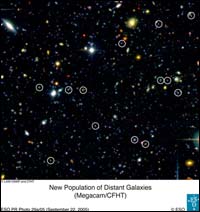A Cosmic Baby-Boom

ESO PR Photo 29a/05 - New Population of Distant Galaxies. Colour-composite image of a portion of the sky surveyed, identifying some of the newly found very distant galaxies. (credit: LAM-OAMP/CFHT/ESO)
Large Population of Galaxies Found in the Young Universe with ESO’s VLT
The Universe was a more fertile place soon after it was formed than has previously been suspected. A team of French and Italian astronomers [1] made indeed the surprising discovery of a large and unknown population of distant galaxies observed when the Universe was only 10 to 30% its present age.
This breakthrough is based on observations made with the Visible Multi-Object Spectrograph (VIMOS) as part of the VIMOS VLT Deep Survey (VVDS). The VVDS started early 2002 on Melipal, one of the 8.2-m telescopes of ESO’s Very Large Telescope Array [2].
In a total sample of about 8,000 galaxies selected only on the basis of their observed brightness in red light, almost 1,000 bright and vigorously star forming galaxies were discovered that were formed between 9 and 12 billion years ago (i.e. about 1,500 to 4,500 million years after the Big Bang).
“To our surprise”, says Olivier Le Fèvre, from the Laboratoire d’Astrophysique de Marseille (France) and co-leader of the VVDS project, “this is two to six times higher than had been found previously. These galaxies had been missed because previous surveys had selected objects in a much more restrictive manner than we did. And they did so to accommodate the much lower efficiency of the previous generation of instruments.”
While observations and models have consistently indicated that the Universe had not yet formed many stars in the first billion years of cosmic time, the discovery announced today by scientists calls for a significant change in this picture. The astronomers indeed find that stars formed two to three times faster than previously estimated.
“These observations will demand a profound reassessment of our theories of the formation and evolution of galaxies in a changing Universe”, says Gianpaolo Vettolani, the other co-leader of the VVDS project, working at INAF-IRA in Bologna (Italy).
The full text of this ESO Press Release 24/05, along with two photos and additional information, is available at http://www.eso.org/outreach/press-rel/pr-2005/pr-24-05.html
Media Contact
More Information:
http://www.eso.org/outreach/press-rel/pr-2005/pr-24-05.htmlAll latest news from the category: Physics and Astronomy
This area deals with the fundamental laws and building blocks of nature and how they interact, the properties and the behavior of matter, and research into space and time and their structures.
innovations-report provides in-depth reports and articles on subjects such as astrophysics, laser technologies, nuclear, quantum, particle and solid-state physics, nanotechnologies, planetary research and findings (Mars, Venus) and developments related to the Hubble Telescope.
Newest articles

A universal framework for spatial biology
SpatialData is a freely accessible tool to unify and integrate data from different omics technologies accounting for spatial information, which can provide holistic insights into health and disease. Biological processes…

How complex biological processes arise
A $20 million grant from the U.S. National Science Foundation (NSF) will support the establishment and operation of the National Synthesis Center for Emergence in the Molecular and Cellular Sciences (NCEMS) at…

Airborne single-photon lidar system achieves high-resolution 3D imaging
Compact, low-power system opens doors for photon-efficient drone and satellite-based environmental monitoring and mapping. Researchers have developed a compact and lightweight single-photon airborne lidar system that can acquire high-resolution 3D…





















